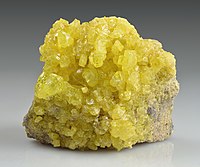
Photo from wikipedia
Abstract Oxidative sulphur cycling is pervasive in marine sediments, replenishing the oxidised sulphur reservoir via re-oxidation of sulphide. An active, yet cryptic, sulphur cycle has been proposed to operate at… Click to show full abstract
Abstract Oxidative sulphur cycling is pervasive in marine sediments, replenishing the oxidised sulphur reservoir via re-oxidation of sulphide. An active, yet cryptic, sulphur cycle has been proposed to operate at depth beneath the sulphate-methane transition (SMT), fuelled by simultaneous sulphide oxidation and sulphate reduction under low-sulphate conditions. The existence of a cryptic sulphur cycle, however, is centred on porewater and genetic data that have little, to no, preservation potential, and thus are rarely accessible from the geological record. The absence of a suitable archive has hindered our ability to reconstruct the operation and importance of the cryptic sulphur cycle through space and time. To overcome this obstacle, and to develop a better understanding of the oxidative sulphur cycle in the deep biosphere, we have determined the abundance and triple sulphur isotope composition ( Δ 33 S and δ 34 S) of both elemental sulphur and pyrite extracted from sediments recovered from the methane prone Taixinan Basin, South China Sea. Here, multiple sulphur isotope systematics of pyrite clearly reveal a tiering, with organoclastic sulphate reduction succumbing to sulphate-driven anaerobic oxidation of methane at depth. Importantly, a negative Δ 33 S- δ 34 S correlation was found at the periphery of the SMT that requires repeated and sustained iron-driven sulphide oxidation with concomitant disproportionation of the elemental sulphur product. We conclude that minor sulphur isotopes may provide a unique lens to resolve the cryptic sulphur cycle, allowing the importance of the deep biosphere to be evaluated over geological timescales. In turn, a better understanding of the cryptic sulphur cycle remains central to testing hypotheses linking major elemental cycles and diverse microbial activities that persist under the energy-limited conditions that typify the deep biosphere.
Journal Title: Earth and Planetary Science Letters
Year Published: 2020
Link to full text (if available)
Share on Social Media: Sign Up to like & get
recommendations!